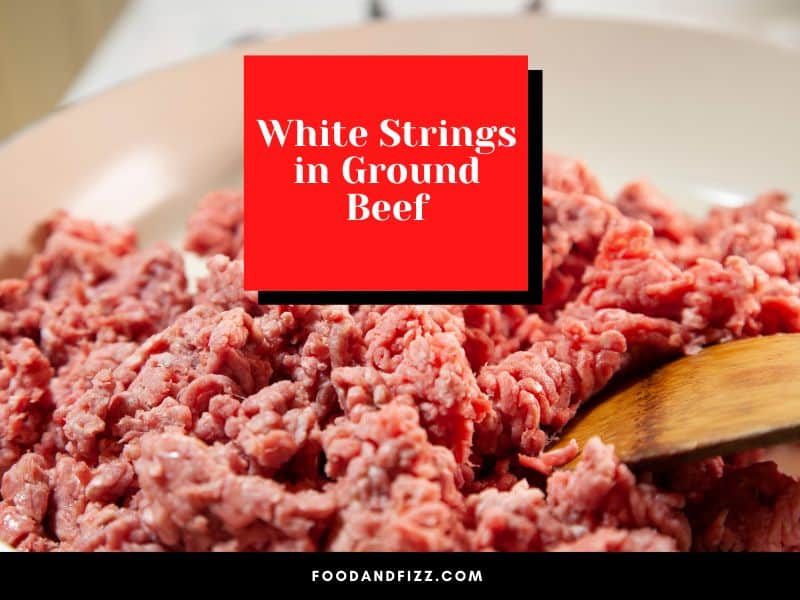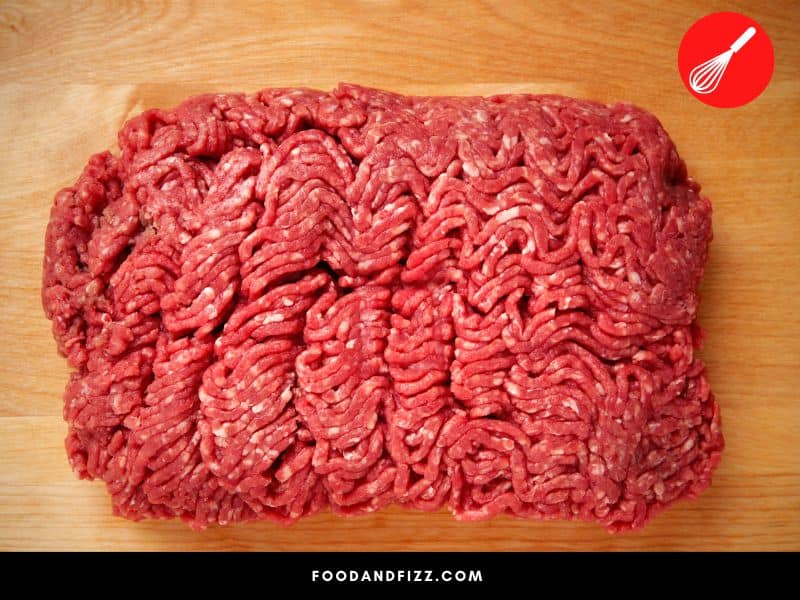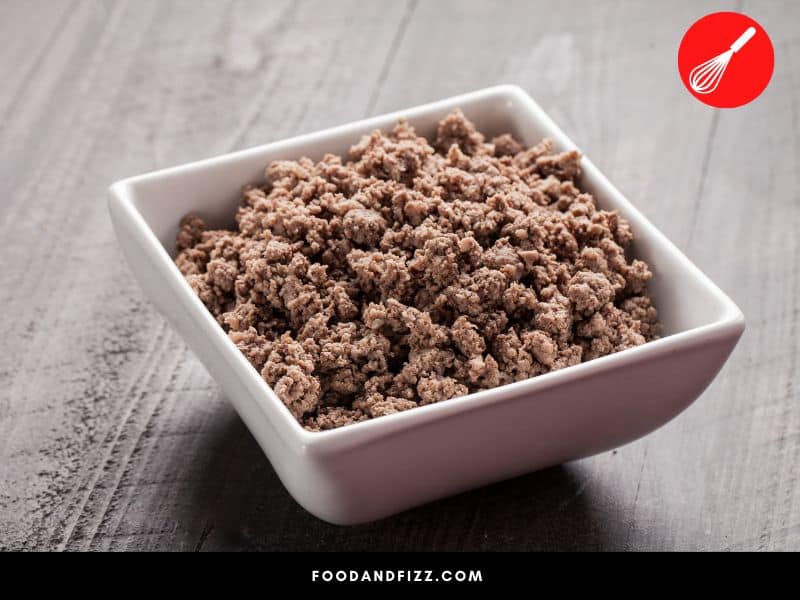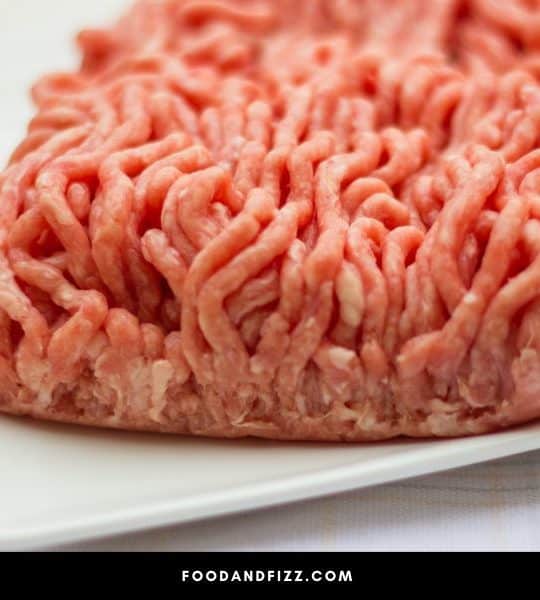Ground beef is a food staple for many homes, and while you may find the occasional bone sliver among the beef, it’s usually a dark red to deep meaty brown color with a few fatty bits.
So what could cause ground beef to have white stringy bits in it? What are these strings, and are they safe to eat? Let’s find out.
What Are White Strings in Ground Beef, and Are These Safe to Eat?
Several things can cause white strings to form in ground beef, including worms, protein that has solidified, connective tissue such as ligaments and sinews, hardened fatty tissue, and even foreign material like plastics. Cooked ground beef may also become stringy if there is a lot of sinews or gristle in the meat that reacts to the heat of being cooked. Gristle, fats, and protein are safe to eat, but worms, plastic, and other foreign materials aren’t safe to eat.

What Causes White Strings in Ground Beef?
There are several things that could appear as white strings in your ground beef. Some of these are perfectly normal, and while a little disgusting, these aren’t harmful to eat. Others aren’t nearly as harmless and should be avoided.
Here are the common culprits forming white strings in ground beef.
White Worms in Ground Beef
Safe to eat? No.
Okay, so worms aren’t as rare in beef (or other meats) as you may think. If the meat had been kept outside, chances are that flies may have lain eggs in the meat, which is then ground up, and a few days later, fly larvae may appear as white worms in the meat.
It’s not advisable to ever eat worms, so if you see white stringy bits wiggle in the meat or appear to have a larval head, discard the meat immediately. Wash your hands and all utensils thoroughly.
Connective Tissue in Ground Beef
Safe to eat? Yes.
While steak and top-grade meat are turned into quality meat cuts, the less tender and meaty bits are often ground up to make ground beef. These sections are dense in connective tissue such as sinews, ligaments, and muscles.
If the meat grinder isn’t set to the finest setting, it will leave some of the connective tissue (or gristle) intact. In your raw ground meat, this will show up as white stringy bits. Once cooked, the ground beef will almost appear to have some fishing line running through it.

Ground Beef With White Spots After Thawing
Safe to eat? Yes (if fatty tissue).
The white strings you see in ground beef may also appear like dots or spots after you’ve thawed the meat. In this case, you are likely dealing with fatty connective tissue that has turned white since it set in the freezer.
If you take one of these spots between your thumb and index finger, the feeling should be greasy, just like a bit of frozen butter. However, if the sensation is grainy, it’s best to discard the meat as the white spots may then be infested with worms or worm eggs.

Cooked Ground Beef and White Spots
Safe to eat? Yes.
When meat is heated up, such as during the cooking process, there is a significant amount of shrinkage. The loss of mass is due to the connective tissues hardening and losing volume, while the fat melts away.
The elastin or protein that makes up the volume of the beef can begin to harden and turn white. Hardened elastin may show up in your cooked ground beef as white spots.
If the meat was not ground up, the “spots” would have been white stringy bits from sinews and micro tendons running throughout the meat.
Did You Know? The age of the beef will influence how many white spots will form during cooking. Older beef will show more gristle or spots when heated.
The higher the heat, the more the likelihood of white spots or white strings forming as the connective tissue will discolor much faster. This is why cooking meat over a high heat produces stringy and “chewy” meat.

White Spots All Over the Defrosted Ground Beef
Safe to eat? Yes.
When you defrost ground beef, note any white spots that seem to be over an indentation in the meat. You may have mistakenly frozen the meat with air pockets around it.
The result is that the air pockets super-freeze, creating freezer burn in these spots. The meat may have a whitish appearance in these areas.
Foreign Material as White Spots in Ground Beef
Safe to eat? No.
Heard the story of someone who found a tooth in their ground beef? We have all heard some horror stories about what could actually be in ground beef.
Fact is, any number of foreign materials may end up being ground up with beef at the local butchery or production line abattoir.
Don’t be surprised if the white stringy bits are actually plastic packets that have ended up in the grinder or even leftover hide from the steer that was slaughtered for the beef.

Frequently Asked Questions to White Strings in Ground Beef
Why is My Ground Beef Grainy?
When cooking ground beef, the secret is to cook it over a medium heat and only brown it until “cooked.” Cooking ground beef for long will harden the ground up gristle or sinews that are often part of the ground beef package. The result is grainy meat that’s not nearly as tasty as it should be.
What Are The White Dots on Raw Ground Beef?
Two things can make white dots on raw ground beef. Firstly, it may be as simple as the fatty tissue whitening after being defrosted, or secondly, it can be fly larvae that have infested the meat and were ground up in the grinder.
How Can I Tell if the Ground Beef I Bought Is Off?
Meat poisoning can make you seriously sick, so it’s best not to take any chances. If you smell the thawed meat and there are any off odors or a metallic tang to the meat, it’s probably spoiled. Should you find any grainy white bits, you may have found fly larvae or eggs, and you should discard the meat.
The Final Strings
Ground beef is an easy meal for most people, so it’s quite distressing if you take the meat out in the morning to defrost in the fridge while you’re at work, only to come home to white spotty and stringy beef.
Take care to freeze ground beef correctly, by flattening the portions in a freezer bag and even vacuum sealing it.
Only buy from reputable butcheries to avoid any chance of worms and eggs spoiling the meat, and cook your ground beef over a medium heat for as long as it takes to cook through, but no longer.

